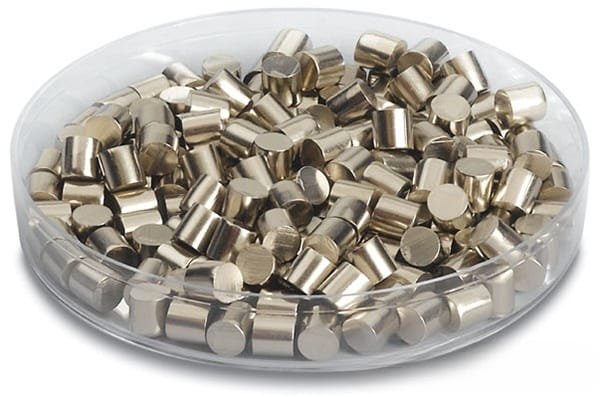Nickel Evaporation Material Description
Nickel is a silvery-white, hard, and ductile metal valued for its excellent polish and corrosion resistance. With a density of 8.91 g/cc, a melting point of 1,453°C, and a vapor pressure of 10^-4 Torr at 1,262°C, nickel is known for its malleability, ductility, and ferromagnetic properties. It resists tarnishing in air and is the second most prevalent element in the Earth’s core after iron. While nickel is widely used in producing stainless steel, coins, and batteries, its use in jewelry has declined due to potential skin allergies.
In deposition processes, high-purity nickel evaporation materials are crucial for producing high-quality deposited films. TFM specializes in crafting nickel evaporation materials with purities reaching up to 99.99%, ensuring product reliability through rigorous quality control measures.

Nickel Evaporation Material Specification
| Material Type | Nickel |
| Symbol | Ni |
| Color/Appearance | Lustrous silvery metal |
| Melting Point | 1455 °C |
| Density | 8.902 g/cm3 |
| Thermal Conductivity | 90.9 W·m-1·K-1 (25°C) |
| Electrical Resistivity | 69.3 nΩ·m (20 °C) |
| Ferromagnetic | Magnetic Material |
| Synonyms | Ni Pellets, Ni Pieces, Ni Evaporation Pellet, Nickel Pellets, Nickel Pieces, Nickel Evaporation Pellet |
Nickel Evaporation Material Application
Nickel evaporation materials are widely used in various deposition processes, including semiconductor deposition, chemical vapor deposition (CVD), and physical vapor deposition (PVD).
In optics, they serve key roles in applications like wear protection, decorative coatings, and display technologies.
Nickel Evaporation Material Packaging
We take great care in handling our nickel evaporation materials to prevent any damage during storage and transportation. This careful management ensures that the quality of our products remains uncompromised, arriving in their original, pristine condition.
Get Contact
TFM offers a wide range of nickel evaporation materials, available in different forms, purities, sizes, and prices to meet diverse needs. Our specialty lies in producing high-purity e-beam evaporation materials, characterized by the highest density and the smallest average grain sizes. For the latest pricing on our evaporation pellets and other deposition materials not listed, please reach out to us with your inquiry.
Ordering Table
| Material | Size | Quantity | Purity | Part Number |
| Nickel | 1/4" Dia. x 1/2" Length | 1 lb. | 99.98% | EVMNI38QXH |
| Nickel | 1/4" Dia. x 1/2" Length | 1 lb. | 99.995% | EVMNI45QXH |
| Nickel | 1/4" Dia. x 1/2" Length | 100 g | 99.995% | EVMNI45QXHD |
| Nickel | 1/4" Dia. x 1/4" Length | 1 lb. | 99.995% | EVMNI45QXQ |
| Nickel | 1/4" Dia. x 1/4" Length | 25 g | 99.995% | EVMNI45QXQA |
| Nickel | 1/4" Dia. x 1/4" Length | 50 g | 99.995% | EVMNI45QXQB |
| Nickel | 1/4" Dia. x 1/4" Length | 100 g | 99.995% | EVMNI45QXQD |
| Nickel | 1/4" Dia. x 1/4" Length | 225 g | 99.995% | EVMNI45QXQI |
| Nickel | 1/4" Dia. x 1/4" Length | 250 g | 99.995% | EVMNI45QXQJ |
| Nickel | 1/8" Dia. x 1/4" Length | 1 lb. | 99.995% | EVMNI45EXQ |
| Nickel | 1/8" Dia. x 1/8" Length | 1 lb. | 99.98% | EVMNI38EXE |
| Nickel | 1/8" Dia. x 1/8" Length | 25 g | 99.98% | EVMNI38EXEA |
| Nickel | 1/8" Dia. x 1/8" Length | 50 g | 99.98% | EVMNI38EXEB |
| Nickel | 1/8" Dia. x 1/8" Length | 100 g | 99.98% | EVMNI38EXED |
| Nickel | 1/8" Dia. x 1/8" Length | 1 lb. | 99.995% | EVMNI45EXE |
| Nickel | 1/8" Dia. x 1/8" Length | 25 g | 99.995% | EVMNI45EXEA |
| Nickel | 1/8" Dia. x 1/8" Length | 50 g | 99.995% | EVMNI45EXEB |
| Nickel | 1/8" Dia. x 1/8" Length | 100 g | 99.995% | EVMNI45EXED |
| Nickel | 1/8" Dia. x 1/8" Length | 250 g | 99.995% | EVMNI45EXEJ |
| Nickel | 1/8" Dia. x 1/8" Length | 500 g | 99.995% | EVMNI45EXET |


 MSDS File
MSDS File



Reviews
There are no reviews yet.